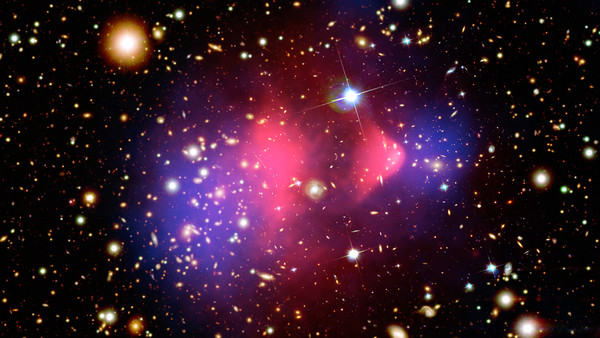10 Controversial Theories About The Universe's Toughest Questions
5. Dark Matter: Science Speak For "We Don't Know"

So, Dark Matter right... is matter, which is, like, dark. Thats it. Thats pretty much all we know.
Our entire sum of knowledge on Dark Matter is that it does not interact with the electromagnetic field and as such does not absorb, emit to or interact with light, or any other electromagnetic wave for that matter. At least that's the theory.
So why do we even talk about Dark Matter if we don't even know it exists? Well, we can measure its effects. Remember the stars spinning too fast on the edges of galaxies that we briefly touched on earlier? That, it is said, is down to Dark Matter. The theory of gravity that we have simply cannot explain how the galaxies are even still together since they should have flown apart eons ago. Dark Matter is inferred because if the theory of gravity is correct then there has to be roughly 26% more matter in the universe than we can currently see.
The galaxies are there, they don't fly apart, our theory of gravity explains everything else we see so beautifully, there must be extra matter there that we can't see. It might be cold dark matter or it might be warm dark matter, we can't see it, but we can see its effects. So what can it be?
The most prominent candidates for Dark Matter are WIMPS or Weakly Interacting Massive Particles. Which are, as the name suggests, massive particles that interact weakly with each other and normal matter. Another possibility is baryonic gas clouds but the evidence is not there to support that theory. It is said not to be anti-matter as we do not see the required gamma emissions from annihilation events, however, what if the antimatter is of a different type and with different properties than we expect? Could there be anti-matter black holes, anti-matter planets and even anti-matter stars co-existing in our own galaxy but shielded from interacting with normal matter by its effect on space-time causing the apparent discrepancy of 6-1 mass ratio?
One interesting candidate is the Hidden Valley series of models. What this basically proposes is a non-interacting set of particles, not anti-matter in the classic sense (which is simply normal matter with reverse spin and charge) but more of a negative matter. This matter would interact with space-time, allowing gravitational effects to be inferred, but would not usually interact with normal matter (perhaps since it only makes up 5% of the universe we should stop calling it that).
Effectively a negative Higgs potential, this would propel waves not up the Mexican hat potential but down. These particles would exhibit properties of anti-time and could, in theory, be good candidates for explaining some of the more exotic Feynman diagrams.
Thats a lot of words for "we have no idea."